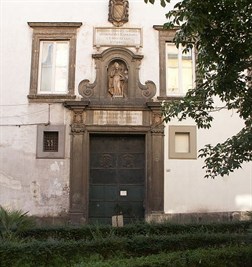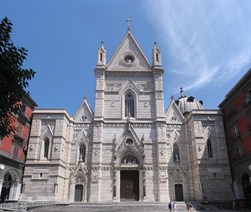The Archbishop’s Palace and the Cathedral
In addition to the family palace, Ascanio Filomarino’s imprint is still visible in some places, symbols of the city of Naples.
 The Archbishop’s Palace, situated between the Cathedral and largo Donnaregina, was erected on the ruins of an early Christian basilica, between the fourteenth and fifteenth centuries. It was built at the behest of the then archbishop and cardinal Enrico Capece MinutoloEnrico Capece Minutolo (? -1412) was archbishop of Naples from 1389 to 1400. Elected cardinal in 1389, he died in Bologna 23 years later and was buried in the family chapel in the cathedral of Naples., whose coat of arms still dominates the main portal. The structure and appearance of the building were, however, changed significantly during the seventeenth century, first by the restructuring ordered by Cardinal Decio CarafaA member of one of the most prominent families of southern nobility, Decius Carafa (1556-1626) embarked on a long career in the church before being made a cardinal by Pope Paul V in 1611. Two years later he was elected archbishop of Naples. He is buried in the cathedral of Naples., then with more radical transformations desired by Filomarino, between 1643 and 1650. Externally, the archbishop decided to demolish some of the surrounding buildings and commissioned an architect from Bologna, Bonaventura PrestiBonaventura Presti (? -1685) was a friar, a native of Bologna. He became famous for his work as a carpenter, architect and engineer in Baroque Naples., for the expansion and the restoration work. The palace was enlarged and three new portals in trachytic rock were opened on the façade. A marble statue of San Gennaro (Saint Genarius) was placed on the middle one (photo) then restored in the following century. The interior of the palace was adorned with a series of frescoes, especially those made by one of Filomarino’s favourite artists: Giovanni LanfrancoBorn near Parma, Giovanni Lanfranco (1582-1647) worked closely with the Carracci and Guido Reni among Roma and Parma, linking Baroque ideas and Classical themes. His stay in Naples was important (1634-1646), where he worked in key places such as the Chapter house of San Martino, the Church of the Gesù and the Chapel of San Gennaro in the Cathedral, representing a model in the transition from Caravaggio’s school to the great flourishing of the Neapolitan Baroque..
The Archbishop’s Palace, situated between the Cathedral and largo Donnaregina, was erected on the ruins of an early Christian basilica, between the fourteenth and fifteenth centuries. It was built at the behest of the then archbishop and cardinal Enrico Capece MinutoloEnrico Capece Minutolo (? -1412) was archbishop of Naples from 1389 to 1400. Elected cardinal in 1389, he died in Bologna 23 years later and was buried in the family chapel in the cathedral of Naples., whose coat of arms still dominates the main portal. The structure and appearance of the building were, however, changed significantly during the seventeenth century, first by the restructuring ordered by Cardinal Decio CarafaA member of one of the most prominent families of southern nobility, Decius Carafa (1556-1626) embarked on a long career in the church before being made a cardinal by Pope Paul V in 1611. Two years later he was elected archbishop of Naples. He is buried in the cathedral of Naples., then with more radical transformations desired by Filomarino, between 1643 and 1650. Externally, the archbishop decided to demolish some of the surrounding buildings and commissioned an architect from Bologna, Bonaventura PrestiBonaventura Presti (? -1685) was a friar, a native of Bologna. He became famous for his work as a carpenter, architect and engineer in Baroque Naples., for the expansion and the restoration work. The palace was enlarged and three new portals in trachytic rock were opened on the façade. A marble statue of San Gennaro (Saint Genarius) was placed on the middle one (photo) then restored in the following century. The interior of the palace was adorned with a series of frescoes, especially those made by one of Filomarino’s favourite artists: Giovanni LanfrancoBorn near Parma, Giovanni Lanfranco (1582-1647) worked closely with the Carracci and Guido Reni among Roma and Parma, linking Baroque ideas and Classical themes. His stay in Naples was important (1634-1646), where he worked in key places such as the Chapter house of San Martino, the Church of the Gesù and the Chapel of San Gennaro in the Cathedral, representing a model in the transition from Caravaggio’s school to the great flourishing of the Neapolitan Baroque..
 The Cathedral of Santa Maria Assunta (Saint Mary of the Assumption, photo), located next to the Archbishop’s Palace, is another building of strong symbolic value on which Ascanio Filomarino has left its mark. Of medieval origin (thirteenth-fourteenth centuries), the cathedral was consecrated in 1644 by the archbishop himself. The Royal Chapel of the Treasury of San Gennaro was instead erected as a votive offering to the saint for the protection accorded to the Neapolitans during the plague of 1526. Among the most wonderful examples of Baroque architecture in Naples, it was completed in 1646 according to a design by the monk Francesco GrimaldiFrancesco Grimaldi (1543-1630) was an architect, a native of Lucania. A Theatine friar, he created significant works in Naples, including the Church of the Santi Apostoli (Holy Apostles), and also worked at the Chapel of the Treasury in the Cathedral. and took the place of the previous three chapels of the Capece, Cavaselice and Filomarino families. Inside you can admire sculptures and paintings by Giuliano FinelliFrom Carrara, Giuliano Finelli (? -1653) was a sculptor, active mainly in Rome and Naples. He collaborated with Gian Lorenzo Bernini. Between 1636 and 1646 he created the bronze statues of patron saints in the Chapel of the Treasury of San Gennaro., Giovanni Lanfranco, DomenichinoAnother great exponent of the Bolognese school of painting of the second half of the sixteenth century, Domenico Zampieri, called Domenichino (1581-1641) had the same training as Guido Reni and Francesco Albani. A pupil of the Mannerist Calvaert, he was trained in contact with the Carracci and in particular, during his formative stay in Rome, with Annibale. He always remained attached to the influence of Carracci and to the influence of Classicism and gradually became an artist of secondary importance due the triumph of Baroque artists such as Giovanni Lanfranco. He died in Naples, where he lived his last years. and Jusepe de Ribera, while Cosimo Fanzago designed and built the brass entrance, the marble floor and the bust of San Gennaro. Next to the Chapel of the Treasury is the Museum of the Treasure of San Gennaro, which houses paintings, statues, busts, jewelry and fabrics donated through the centuries by popes, kings, important personalities and unknown people.
The Cathedral of Santa Maria Assunta (Saint Mary of the Assumption, photo), located next to the Archbishop’s Palace, is another building of strong symbolic value on which Ascanio Filomarino has left its mark. Of medieval origin (thirteenth-fourteenth centuries), the cathedral was consecrated in 1644 by the archbishop himself. The Royal Chapel of the Treasury of San Gennaro was instead erected as a votive offering to the saint for the protection accorded to the Neapolitans during the plague of 1526. Among the most wonderful examples of Baroque architecture in Naples, it was completed in 1646 according to a design by the monk Francesco GrimaldiFrancesco Grimaldi (1543-1630) was an architect, a native of Lucania. A Theatine friar, he created significant works in Naples, including the Church of the Santi Apostoli (Holy Apostles), and also worked at the Chapel of the Treasury in the Cathedral. and took the place of the previous three chapels of the Capece, Cavaselice and Filomarino families. Inside you can admire sculptures and paintings by Giuliano FinelliFrom Carrara, Giuliano Finelli (? -1653) was a sculptor, active mainly in Rome and Naples. He collaborated with Gian Lorenzo Bernini. Between 1636 and 1646 he created the bronze statues of patron saints in the Chapel of the Treasury of San Gennaro., Giovanni Lanfranco, DomenichinoAnother great exponent of the Bolognese school of painting of the second half of the sixteenth century, Domenico Zampieri, called Domenichino (1581-1641) had the same training as Guido Reni and Francesco Albani. A pupil of the Mannerist Calvaert, he was trained in contact with the Carracci and in particular, during his formative stay in Rome, with Annibale. He always remained attached to the influence of Carracci and to the influence of Classicism and gradually became an artist of secondary importance due the triumph of Baroque artists such as Giovanni Lanfranco. He died in Naples, where he lived his last years. and Jusepe de Ribera, while Cosimo Fanzago designed and built the brass entrance, the marble floor and the bust of San Gennaro. Next to the Chapel of the Treasury is the Museum of the Treasure of San Gennaro, which houses paintings, statues, busts, jewelry and fabrics donated through the centuries by popes, kings, important personalities and unknown people.
Filomarino wanted to leave a testimony of the role played by his family in the history of the city through some busts of his ancestors: Giovanni BattistaGiovanni Battista Filomarino della Rocca (?-1578) was a Neapolitan count, the father of Tommaso and Marcantonio Filomarino. His bust, sculpted by Giuliano Finelli, is in the Cathedral of Naples and Tommaso Filomarino della RoccaTommaso Filomarino della Rocca (?-1630) was Giovanni Battista’s eldest son. He was awarded the title of prince della Rocca by the King of Spain in 1610. A bust of him, sculpted by Giuliano Finelli, is in the Cathedral of Naples., sculpted by Giuliano Finelli, and Marcantonio Filomarino della RoccaThe second son of Giovan Battista, Marcantonio Filomarino della Rocca (?-1634) succeeded his brother Tommaso as the prince della Rocca. He was one of the greatest collectors of his time in Naples. Giulio Mencaglia sculpted his traits in a monument in the Cathedral of Naples., by Giulio MencagliaGiulio Mencaglia (1615/20-1649) was an artist born in Carrara but active mainly in Naples in the Baroque period..
Between the seventeenth and eighteenth century various Baroque interventions took place in the Cathedral which are clearly visible in the chapels, in stucco and marble and numerous paintings placed in different corners of the building. Additions and changes followed in subsequent centuries, until the neo-Gothic façade was erected in the nineteenth century. Damaged by bombing during the Second World War, the Cathedral of Naples was further restored in the course of the twentieth century. Inside excavations are also visible that have unearthed Roman, Greek and early medieval ruins. Three times a year the ritual of the dissolution of the blood of San Gennaro is staged inside.
